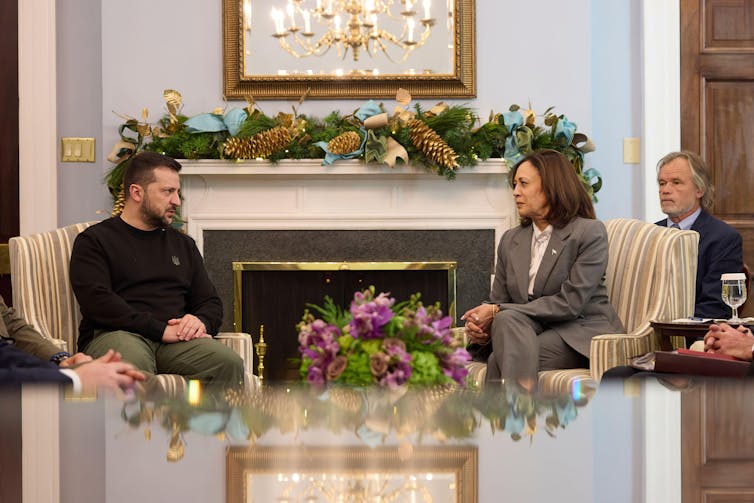One-third of Ukrainians would give up land for peace – but it’s not as simple as that
According to a recent opinion poll taken by the Kyiv International Institute of Sociology, almost one-third of Ukrainians are now prepared to make territorial concessions to Russia if this brings the Russian war of aggression to a swift end and preserves their country’s independence. But more than half of the population rejects the idea of giving up territory for peace.
This may give an impression of a solid majority against concessions, but the increase among those willing to compromise is dramatic. It had remained at or below 10% until May, 2023. But with relentless bad news form the battlefront since the failure of last year’s spring and summer offensive, it has risen steadily to the current 32%.
The growing war-weariness of increasing numbers of Ukrainians is unlikely to be reversed anytime soon given that Russia continues to advance along the almost 1,200km-long frontline, especially in the critical Donetsk sector. Although, it must be noted, there have been no significant strategic breakthroughs – and the advances have come at tremendous cost in terms of lives on both sides.
Even if a majority of Ukrainians were eventually willing to trade some territory for peace, it’s not clear what a credible peace plan would look like.
Read more: Ukraine summit fails to provide a path to peace for Kyiv and its allies
Ukraine has not officially abandoned its idea of a global coalition of states pressuring Russia to end its aggression and withdraw from all the Ukrainian territory it has illegally occupied since 2014. But this looks like a vanishingly slim prospect.
So there needs to be a rethink of how Moscow and Kyiv can reach a mutually acceptable peace agreement that will stick. It’s inconceivable this could happen without the active engagement of Beijing and Washington, and possibly a larger contact group of countries in a way that has been successfully used in the past.
Beijing shift towards Moscow
Recent efforts by Ukraine’s foreign minister, Dmytro Kuleba, to involve China in peace-making efforts seem to have faltered for now. Following their meeting in Guangzhou on July 24, China’s foreign minister, Wang Yi, noted that the conditions for negotiations between Kyiv and Moscow were not ripe yet.

The Chinese position is now that they “support all efforts that are conducive to peace and are willing to continue to play a constructive role in ending the ceasefire and the resumption of peace talks”. This is much more minimalist than Ukraine’s vision of a “a lasting and just peace” that entails the full restoration of the country’s sovereignty and territorial integrity in its internationally recognised 1991 borders.
It’s also a striking contrast to China’s position paper on Ukraine from February 24 2023. This emphasised that “the sovereignty, independence and territorial integrity of all countries must be effectively upheld”. Now Beijing’s position is now much more closely aligned with Moscow’s, which focuses on a ceasefire to freeze the current front lines.
Changing face of Washington
The other part of the equation is Washington. Donald Trump’s choice of a vice-presidential running-mate who said he couldn’t care less what happens to Ukraine seemed to bode ill for Kyiv. But Joe Biden’s withdrawal from the race and a strong initial campaign by his vice-president, Kamala Harris, makes a Trump-Vance White House far less of a foregone conclusion.

And, even if it were, the internal Republican debate on how to deal with the war in Ukraine is far from settled. Trump’s former secretary of state, Mike Pompeo, recently co-authored an opinion piece suggesting a much more muscular approach to achieving peace in Ukraine. While it would also involve territorial concessions, it would include Ukrainian membership in a beefed-up Nato, as well as Kyiv’s swift accession to the EU.
But a Trump-Vance victory in November still looks more promising for Putin than the alternative. Harris has a clear track record as a staunch defender of Ukraine and critic of Putin.
At present it’s far from clear whether Harris would take a tougher line than Biden or simply continue the path Biden has set – policies that, so far, have only prevented Ukraine from losing without providing it with a path to military victory.
Regardless of the outcome of November’s US election, Putin can take comfort from the fact that the current overall trajectory of the war is in his favour. Russia’s gradual gains on the battlefield have chipped away at the Ukrainian people’s willingness to endure whatever hardship is required to restore their country’s 1991 borders.
By the time there will be a new president in the White House in January 2025, this is unlikely to have changed for the better. China is politically clearly on Russia’s side, while Iran and North Korea offer important military supply lines.
The key question in the effort to end the war against Ukraine, therefore, is less about the need for a negotiated solution than it is about how to deal with each side’s red lines. And here, according to current public opinion in Ukraine, the issue of territorial concessions is less problematic than the question of Nato membership.
More than half of the Ukrainians polled reject any deal that includes territorial compromises and simultaneously requires the country to forego Nato membership. But between 47% and 57% were willing to accept different degrees of territorial concessions to Russia if Ukraine can join the transatlantic alliance and receive security guarantees.
If such a compromise between Kyiv and Moscow were achieved, it would most likely come about as a result of pressure from Washington and Beijing. So the real question might be under what circumstances the US and China would see such a compromise, and therefore peace in Ukraine, in their own long-term strategic interests.

No comments:
Post a Comment